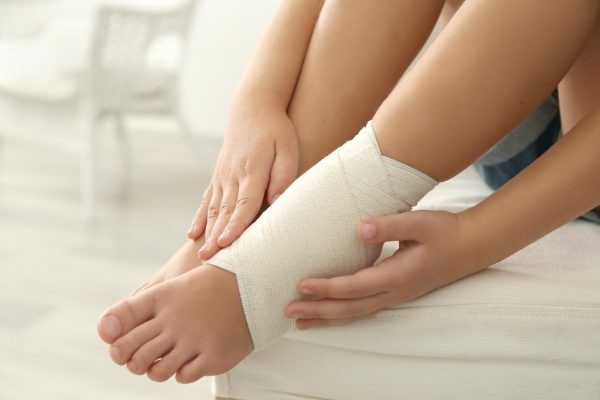Although it may be tempting to ignore a sprain, doing so can make your injury worse and potentially prolong your healing time. That’s why it’s important to take care of your foot or ankle if you suspect a sprain of any degree.
Below, we’ll explore more about these types of injuries and some excellent ways that you can take care of your foot and ankle sprains so you can stand tall.
How Long Does it Take for a Sprain To Heal?
Ankle and foot sprains can occur when the tough tissue (ligaments) supporting a joint are stretched too far or even torn. There are three levels— called degrees of sprain— that can occur.
It may only take two weeks to heal a grade one (minor) sprain. Second and third-grade sprains could take anywhere from six to twelve weeks to fully recover.
Although a grade three sprain is considered the most severe type, pain, bruising, and swelling is possible with any sprain. If you’re in a lot of pain or can’t put weight on your injury, it’s best to see your podiatrist so they can determine if you have a broken bone or a severe sprain. The sooner you see a specialist, the sooner they can get you on your way to recovery.
Ways To Care for Foot and Ankle Sprains
RICE Method
Whenever an accident or sports-related mishap results in pain in your foot or ankle, following the RICE method immediately and continuing treatment for 24 to 48 hours can help reduce swelling and relieve pain.
RICE stands for:
- Rest. Staying off of the injury can prevent it from worsening.
- Ice. Applying ice indirectly for 15 to 20 minutes at a time every 2 to 3 hours can help reduce swelling and may offer some pain relief.
- Compression. Wrapping the sprained foot or ankle in an elastic bandage (not too tightly!) can help stop swelling.
- Elevation. Especially at night, elevating the injured foot or ankle above your heart can help keep the swelling down.

Applying the RICE method for foot and ankle sprain care has been a long-standing practice that can help with specific kinds of sprains and other injuries. However, not all injuries can heal with only the RICE method.
Protection for Foot and Ankle Sprains
When you have pulled or torn ligaments, preventing these soft tissues from becoming more damaged can mean avoiding a longer healing time. Crutches or a splint can take the weight off your injury and protect it from further harm. A splint or brace can also keep the joint aligned and ensure it’s properly healing. Protection options are typically used in combination with the RICE method for maximum healing benefits.
Foot and Ankle Sprain Care Includes Medication When Necessary
When you first sprain your foot or ankle, it’s going to hurt and the RICE method may not be enough to ease the pain. When necessary, taking non-steroidal anti-inflammatory drugs (NSAIDs) can reduce pain and swelling.
A common NSAID for aches and sprains is ibuprofen (brands such as Motrin® and Advil®). However, if the pain continues or you find yourself reaching for medication several days after you first sprained your foot or ankle, it’s important to contact your podiatrist so they can effectively evaluate and treat your injury to get you back on your feet!
Road to Recovery: Rehabilitation
Physical therapy stretches typically start around three days from the day your sprain happened. Podiatrist-prescribed home exercises can be a great way for non-athletes to fully recover mobility and range of motion. Sometimes, getting help from a physical therapist— especially for athletes— is needed to keep you on the right track for proper healing.
A crucial part of foot and ankle sprain care is regaining the strength and flexibility that you had before your ligament(s) sustained damage. Rehabilitation in the form of maintenance exercises can prevent future problems while improving your balance and adaptability.
Six balance exercises to consider are:
- Single-leg balance.
- Single-leg balance with movement.
- Toe-heel walking.
- Single-leg step-downs.
- Walking lunges.
- Single-leg Roman deadlifts.
It’s best to get professional advice on when to start rehabilitation— this can help you get the maximum benefit for your feet and reduce the risk of re-spraining your foot or ankle.
Getting Help With Foot and Ankle Sprains
If you’re still experiencing pain or discomfort even after you’ve properly cared for your foot or ankle sprain, this could indicate a more serious sprain or other issue that requires immediate attention from your foot and ankle doctor.
At The Foot & Ankle Group, we put your feet first so you can get the care you need when you need it. With four convenient locations in Southwest Florida, we’re able to offer same-day appointments for emergencies in most cases. We’re here to help.
Categorized in: Blog
Comments are closed